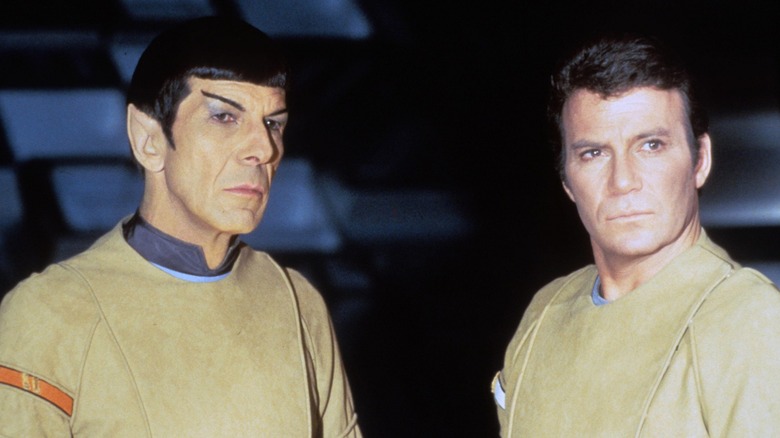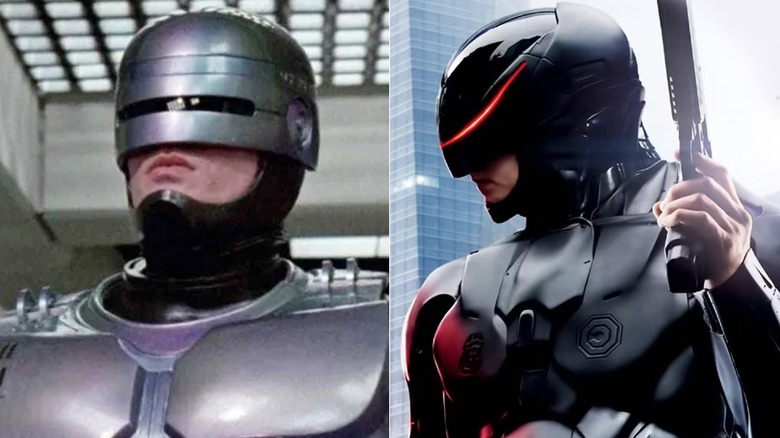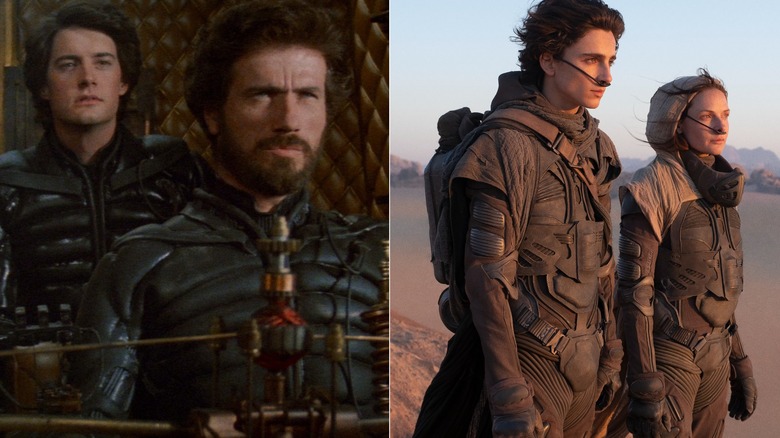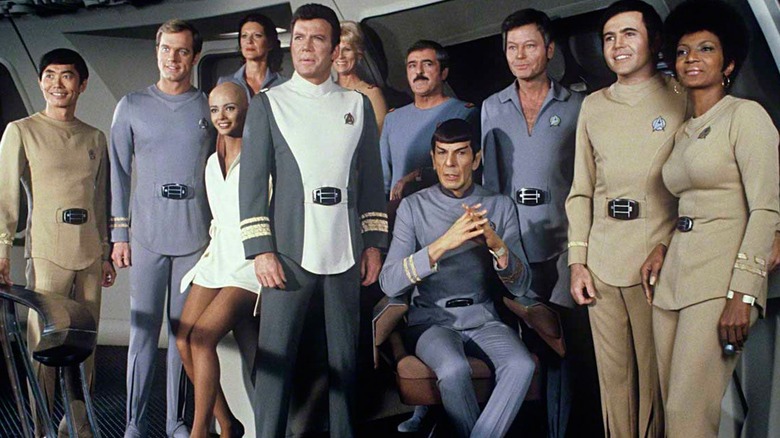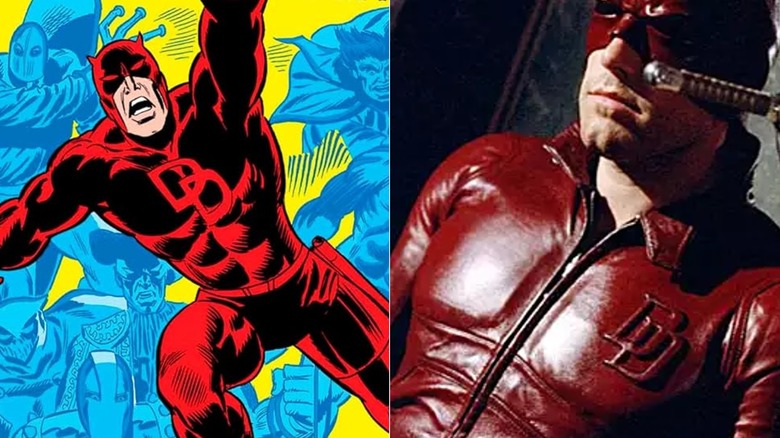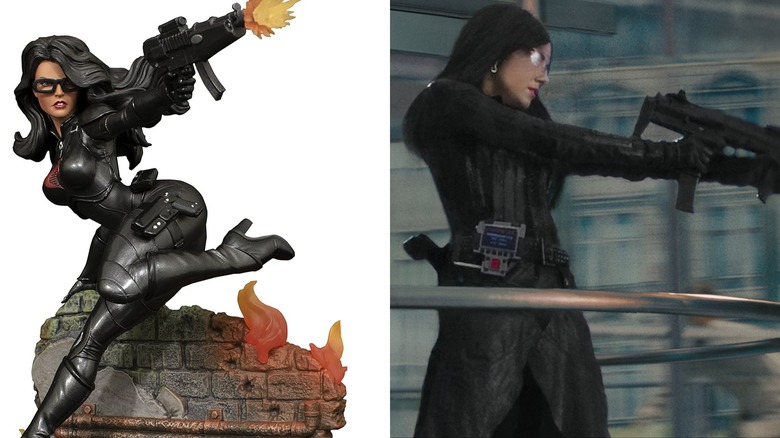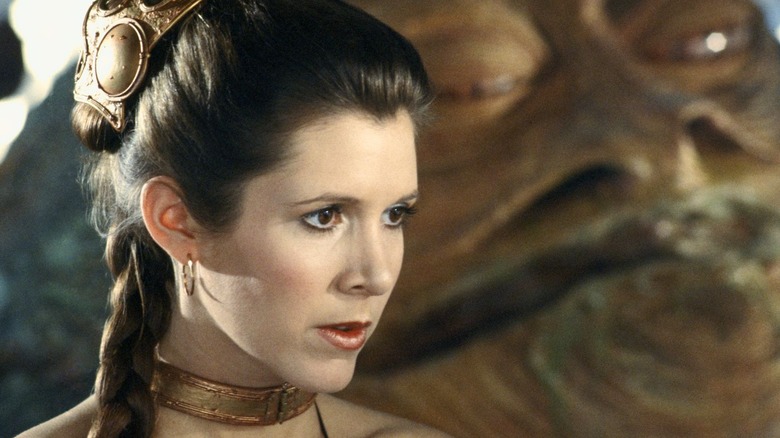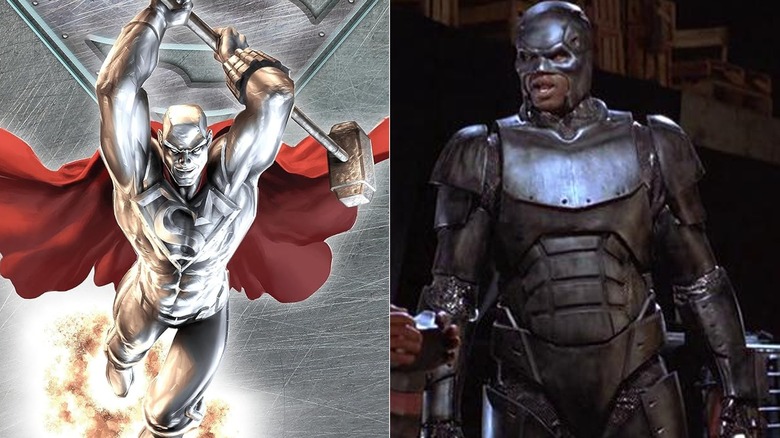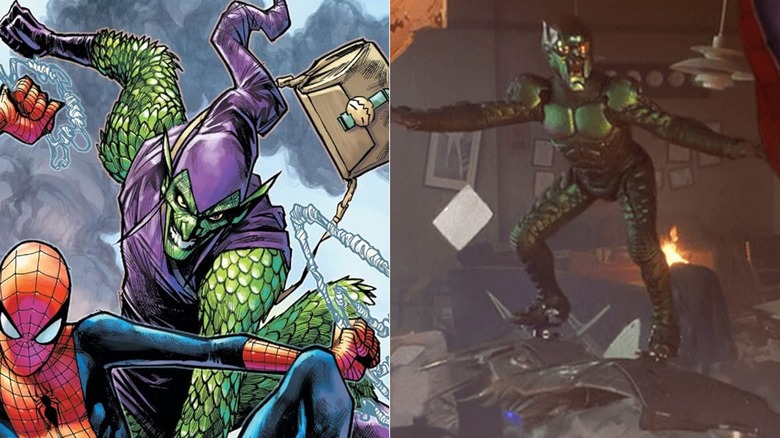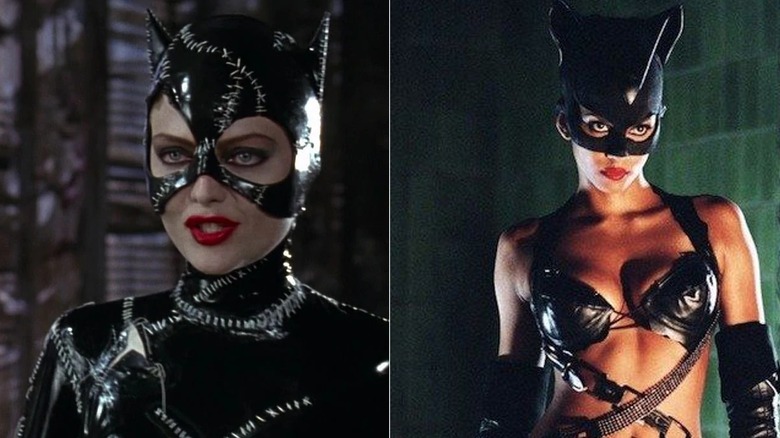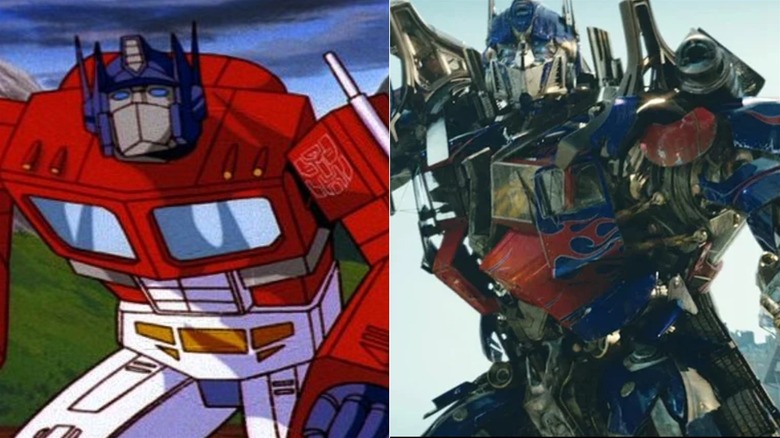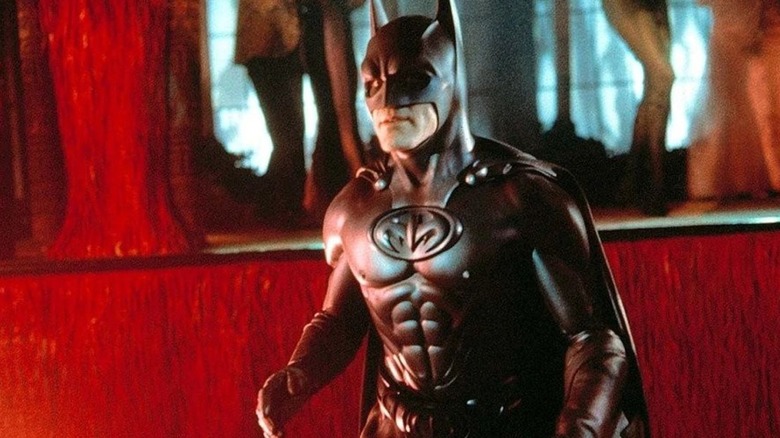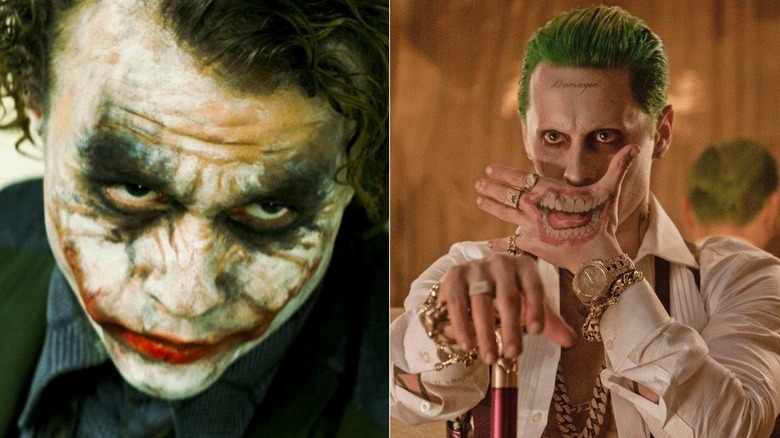The Most Controversial Costume Changes In Sci-Fi Movie History
If there's a constant with cinematic sci-fi franchises, it's this: costume changes between movies allow for more toy designs, and thus sales. If there's a constant for sci-fi movies based on comics, it's that costumes will nearly always get a "more cinematic" redesign. Sometimes, that aligns with what the public wants, like Michael Keaton's 1989 Batsuit, which allayed fears that a less-muscular actor could play an intimidating superhero. Other times, it seems so out of left-field that we wonder what all involved were thinking.
This list encompasses many of these, and more. Whether they be alterations made in adaptation, in between sequels, or as supposed upgrades, the costume changes that follow are those which have engendered the most debate among sci-fi film fans. Sometimes, the debate clearly landed in favor of the initial skepticism. Other times, the changes actually worked for the specific story being told. Either way, as more generations continue to discover these titles, the controversy will likely continue.
Remake RoboCop (RoboCop 2014)
When the first "X-Men" movie came out in 2000, the studio believed the public wouldn't buy brightly colored spandex costumes. Instead, the production dressed the team in black leather, much as "Blade" had done previously with its surprisingly successful Marvel hero. Black outfits were seen as cooler than tights — a brief 1999 panic over trenchcoat use by the Columbine shooters made the all-black look feel even more dangerous. By 2014, though, we had seen the Sam Raimi "Spider-Man" movies and the first phase of the Marvel Cinematic Universe. Turning an outfit black when adapting it to the big screen no longer felt like gritty realism, but faux-cool.
So when the "RoboCop" remake came out, the lead character's makeover in an all-black robo-body just seemed silly rather than edgy. Fans also wondered why he kept a normal-looking, flesh-and-blood hand attached to his powerful cybernetic body. The movie never addresses it in the theatrical cut, but there are actually two explanations for RoboCop's newly human hand. One is a visual metaphor — a human hand on the trigger of a police gun is meant to reassure the public that he's not a soulless machine. A deleted scene offers a more superficial explanation: Raymond Sellars (Michael Keaton) believes in the ability to judge a man by his handshake, and wants to ensure Alex Murphy (Joel Kinnaman) can still put 'er there.
The film itself expresses neither of these, but in the end gives RoboCop a silvery makeover like the original.
Stillsuits (Dune: Part One)
David Lynch's 1984 "Dune" adaptation elicits mixed responses at best, but regardless of a viewer's reaction to the storytelling, few would deny its production design is awesome to behold, even if it's not always true to the Frank Herbert's book. Bob Ringwood's moisture-conserving Stillsuits prefigure his Tim Burton Batsuit design, but they're on that same path, with an H.R. Giger-inspired bio-mechanical anatomy costume look. (Ironically, their lack of breathability in real life made them uniquely terrible at hydrating their actors.)
By comparison, when Denis Villeneuve mounted his production of "Dune," the Stillsuits looked half-assed by comparison; more like regular clothes with extra bits glued on than form-fitting survival devices. The general idea was to make the Stillsuits look more like something actual desert tribes wear today than to look explicitly futuristic and alien. Villeneuve got so much right that in the end, complaints about the costumes faded away and the movie won six Oscars. You know what the movie didn't win the Oscar for, though? Costumes. (In fairness, it was nominated.)
The Enterprise crew (Star Trek: The Motion Picture)
Between the 1969 premiere of the final episode of the original "Star Trek" series and the first movie's 1979 release, fashion changed a lot. So did science fiction aesthetics — in the wake of "2001: A Space Odyssey" and "Star Wars," bright red miniskirts weren't going to cut it in a non-campy film.
Though less garish, the alternatives dreamed up for "Star Trek: The Motion Picture" haven't fared much better over time. Tans and beiges didn't make great uniform colors, some of the faux-naval touches looked more like Carnival cruise uniforms, and the decision to sew the shoes into the pant legs resulted in pointless difficulty changing. Costume design critic Gavia Baker-Whitelaw, writing on her blog Hello Tailor, describes the main issues as threefold: Physical impracticality, visual impracticality, and eye-boggling hideousness. Whitelaw notes that "Starfleet is meant to be so utilitarian and clever," but the outfits are unfortunately hideous.
As described in William Shatner's autobiography, they also got far too tight when the men tried to sit down. Thankfully for all involved, the sequel's attempt at Navy-style formalwear proved more popular all around.
Daredevil (2003's Daredevil)
If there's one thing that can be said for the leather costume worn by Ben Affleck in 2003's "Daredevil" movie, it's that it's better than the full-body blindfold worn by Rex Smith in the 1989 TV movie "The Trial of the Incredible Hulk." If there's anything else that can be said in its favor, we don't know it. The outfit looked more like bondage gear than most super-suits, and that's saying a lot.
"Daredevil" director Mark Steven Johnson knows it, too. "We went all over the place on the costume. It's a really hard one because you get the fans who are upset that it's not spandex," Johnson told Yahoo. "And I thought it should be spandex, too! But then you try spandex and it looks ridiculous ... We ultimately settled on leather because it was the most practical."
Johnson gives all due credit to the costume now worn by Charlie Cox in the Marvel Cinematic Universe as an improvement, acknowledging, "It feels kind of like armor, but there's still leather elements. They did a really nice job with that suit."
Baroness (G.I. Joe: The Rise of Cobra)
For a character based on a kids' toy line, G.I. Joe villain Baroness appeals to some very adult sensibilities. Usually clad in skin tight armor and/or leather, with long black hair, ruby red lips, and glasses, many higher-end collectibles emphasize this spicy combo, and it's a popular look for cosplayers who can pull it off.
Stephen Sommers, who directed 2009's "G.I. Joe: The Rise of Cobra," didn't seem overly concerned about having the characters look like their toy counterparts, and in the case of the Baroness, he seemingly missed her appeal completely. Rather than librarian specs that frame her eyes, Sienna Miller's Baroness mostly wears auto-darkening sunglasses. As for her not-especially contoured bodysuit, it hides under a trench coat half the time. Maybe Sommers just thought "The Matrix" was really cool, but fans didn't come away thinking of this Baroness as especially hot.
Perhaps even worse, the movie takes away her bad girl nature altogether, as it's revealed she's only assisting the evil Cobra organization because of mind-control nanobots. Disable them, and she becomes just plain, sweet Anna again. The misinterpretation of her costume was only the most obvious sign that here was a Baroness in name only. For everything else it got wrong, at least Robert Schwentke's 2021 "Snake Eyes," in rebooting the series, gave us a recognizable version of Cobra's favorite bad girl once again.
Leia's Gold Bikini (Return of the Jedi)
After two movies as a strong leader more competent than the male heroes assigned to rescue her, Princess Leia Organa (Carrie Fisher) got captured and stripped down to a gold bikini by Jabba the Hutt in "Return of the Jedi." For straight male fans of a certain generation, it made for a formative moment, as immortalized in the episode of the sitcom "Friends" when Rachel (Jennifer Aniston) wears the outfit for Ross (David Schwimmer). For women who idolized Leia, it hit a little differently.
Over a decade later, Kenner/Hasbro finally made an action figure of Leia in the get-up, and though it was officially labeled "Leia as Jabba's Prisoner," the fans quickly dubbed it "Slave Leia." The first such figure proved hugely popular with collectors, though after a while the appeal died down. After Disney took over "Star Wars," they quietly started phasing out that particular look in merchandise, along with the word "slave," which also got removed from the name of Boba Fett's starship.
Asked how she would explain the outfit to kids, Fisher had the best answer (via Insider). "Tell them that a giant slug captured me and forced me to wear that stupid outfit, and then I killed him because I didn't like it. And then I took it off. Backstage." More recently, in a rebranding that takes a cue from Fisher's quote, Disney began describing Leia in that outfit as "Huttslayer."
John Henry Irons (Steel)
Long before Sony started making movies like "Venom" about Spider-Man-related characters without Spider-Man, DC tried to do its own Superman-related character movie without Superman. In comics, Steel was John Henry Irons, one of four Superman-esque heroes who appeared after the original Superman's death at the hands of Doomsday. Irons didn't pretend to be Superman, but he wore a caped metal suit that made him resemble a literal Man of Steel. In the movies, he's Shaquille O'Neal in armor that Tony Stark would reject outright.
With no then-current Superman on the big screen, the movie "Steel" (directed by "V" creator Kenneth Johnson) depicts Irons as a brilliant weapons designer, who must protect the inner city when a fellow soldier steals his arsenal and sells it to criminals. Nine years before "Iron Man" hit the big screen, this inventor upset with the misuse of his tech develops a powered-up suit of armor with which to fight evil, along with a giant hammer, inspired by the legend of John Henry. Shaq proves extremely game and seems constantly aware of just how silly the whole thing his, but playing a genius scientist is a little out of his league.
Sans Superman, the film ditched the cape, and in order to showcase Shaq's acting, such as it is, Steel's full-head mask got replaced with a metal cowl, like Batman without the ears. The technology to do a full body mo-cap suit wasn't ready in 1997, and the cumbersome results speak for themselves.
Green Goblin (Spider-Man)
The Green Goblin has one of those costumes that works on the page much more easily than in real life. It's supposed to be deranged tycoon Norman Osborn in, more or less, a Halloween costume and mask. On the page, that mask can be as expressive and realistic as any given artist wants to make it. In reality, a criminal in a rubber mask would just look like exactly that.
Sam Raimi's "Spider-Man" tried to come up with an alternative that would make sense within the world of a movie, and came up with the notion that Osborn would wear green armor to increase his strength, and design a helmet reminiscent of his personal tribal mask collection. Fans derisively described the appearance as resembling a Power Ranger, which isn't particularly a compliment. Even devotees of the "Power Rangers" TV shows will acknowledge the costumes look cheesy.
Willem Dafoe's committed performance helped people overlook their issues with the design, though many fans wondered why Raimi would cast Dafoe — whose face actually looks like a sinister goblin when he grins just right — and then put a mask over him. At long last, in Marvel Studios' "Spider-Man: No Way Home," he kept his natural deranged face and donned a purple hood to look more like the comics. The power armor underneath it all remained for the Raimi movie fans, however.
Catwoman (Catwoman)
When Warner Bros. initially proposed a "Catwoman" movie, the idea was that it should star Michelle Pfeiffer in that stitched up vinyl outfit from "Batman Returns." By the time it came out, we got Halle Berry dressed up like a psychotic hamster in a bikini. What the hell happened?
Said costume designer Angus Strathie (via Cinema Review), "There were so many elements to take into consideration because the cat suit is such a distinctive, almost historical costume. We did want to pay some homage to the other Catwomen and I think we achieved a wonderful blend of the past and the not-too-distant future."
Director Pitof, a graphic designer and still photographer, didn't feel bound by existing continuity, and parental backlash to the perceived kinkiness of Pfeiffer's version didn't help. Ironically, in the comics the classic Selina Kyle Catwoman had recently gotten a popular costume makeover featuring a full bodysuit and goggles. The movie's Catwoman, however, was an all-new creation named Patience Phillips, in a city that definitely didn't resemble Gotham.
The movie did not become a blockbuster, possibly because the costume clued fans in that it would not be good. Still, it won Halle Berry a Razzie award the same year she won the Oscar for "Monster's Ball."
Optimus Prime (Transformers)
Michael Bay never particularly claimed to know much about Transformers, as toys or otherwise. His primary interest as director of five live-action films in the movie franchise seemed to be that really cool, fast cars could also turn into robots, allowing for double the options when blowing stuff up real good. So when he added painted flames to Autobot leader Optimus Prime, in both robot and truck mode, old-school fans rebelled.
In order to make the transformations look like believable mass-shifting while still allowing for riders inside in vehicle mode — something the toys never worried much about — the robot models became far more complex on screen, and in the end the red flames on a blue body helped keep Optimus' familiar color scheme somewhat intact. With veteran Peter Cullen still providing the voice, this remained a recognizable hero, though later installments that showed him with PTSD, relishing the slaughter of his enemies, raised several eyebrows to say the least.
Regardless, at least the Bay movies realized they needed Prime. The 1986 "Transformers" animated movie flat-out killed him off, presuming fans would be happy with the Judd Nelson-voiced Hot Rod as a substitute. They were not.
Batman (Batman Forever and Batman & Robin)
Between Tim Burton's first "Batman" and "Batman Returns," Michael Keaton's Batsuit evolved from looking like an organic physique to plated armor. When Joel Schumacher took over as director for "Batman Forever," the design reverted back to an anatomical look. Emulating classical statues, Val Kilmer's initial Batsuit sported a more realistic chest and a sculpted rear, both of which get their closeups in the movie's intro. Perhaps because he reverted to an armor-styled sonar suit for the climax, fans really seemed to reserve their ire for the subsequent film, "Batman & Robin," in which George Clooney's Bat-pecs appeared to be even more on display.
Costume designer Jose Fernandez explained (via Dexerto), "it was more informed by Roman armor — like Centurions. And, in the comic books, the characters always looked like they were naked with spray paint on them — it was all about anatomy, and I like to push anatomy."
Joel Schumacher, a gay man and former costume designer himself, defended his vision. Considering fans were relatively quiet about Alicia Silverstone's sculpted chest armor as Batgirl, there's certainly a case to be made that homophobia played a part in the great Bat-panic of the '90s. "If I wasn't gay, they would never say those things," Schumacher told Vulture in 2019.
Joker (The Dark Knight and Suicide Squad)
In comics, the Joker is generally a skinny, dapper fellow with purple coattails, and a face transformed by chemical exposure to have white skin and green hair. Jack Nicholson's 1989 movie version stuck pretty closely to that look, as did Cesar Romero on the 1966 TV show. When fans first glimpsed Heath Ledger in clips from "The Dark Knight," however, several aspects seemed off.
Rather than a bright splash of color against the darkness of Gotham City, Ledger wore a more muted purple. The clown hair and face were clearly dye and makeup, and sloppily applied at that. But once the movie came out and Ledger's actual performance nailed the clown prince of crime's personality, fans rejoiced, and the actor won an Oscar (a posthumous one, tragically). The movie's logic that Joker donned "war paint" was far from canonical, but Ledger's embrace of chaos worked in spite of it.
Fans again worried when images of Jared Leto's Joker first hit the web, complete with the L.A. gangster aesthetic favored by "Suicide Squad" director David Ayer. Covered in tattoos and sporting metal teeth, he showed bleached skin and hair, but otherwise dressed more like a modern-day pimp. The logic behind the character appearance? After this Joker murdered Robin, Batman knocked his teeth out, prompting the "Damaged" tattoo on his forehead. "Suicide Squad" fared well at the box office; critically, less so.
(There was also, of course, discourse around the look of Joaquin Phoenix's Joker, but as that 2019 solo drama lacks any elements of sci-fi, it's outside the bounds of our discussion here.)
